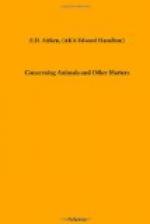Compared with all these, the birds that can do with a diet of fruit only lead an easy life. They have just to pluck and eat—that is, if they are pleased with small fruits and content to swallow them whole. But the hornbills, being too bulky to hop among twigs, need a long reach; hence the portentous machines which they carry on their faces. The beak of a hornbill is nothing else than a pair of tongs long enough to reach and strong enough to wrench off a wild fig from its thick stem. If it were of iron it would be thin and heavy; being of cellular horn-stuff it is bulky but light. If you ask why it should rise up into an absurd helmet on the queer fowl’s head, I cannot tell. Nature has quaint ways of using up surplus material.
[Illustration: ITS BILL DESERVES STUDY]
An easy life begets luxury, and among fruit-eaters the parrot has become an epicure. It will not swallow its food whole, and its bill deserves study. In birds generally the upper mandible is more or less joined to the skull, leaving only the lower jaw free to move. But in the parrot the upper mandible is also hinged, so that each plays freely on the other. The upper, as we all know, is hooked and pointed; the lower has a sharp edge. The tongue is thick, muscular, and sensitive. The whole makes a wonderful instrument, unique among birds, for feelingly manipulating a dainty morsel, shelling, peeling, and slicing, until nothing is left but the sweetest part of the core. Of all gourmands Polly is the most shameless waster.
Long before land, trees, and air had been exploited the primitive bird must have discovered the harvest of the waters, and here the competition has been very keen indeed. Yet the form of bill most in use is very simple—just a plain pair of forceps, long and sharp-pointed like scissors. This is evidently hard to beat, for birds of many sorts use it, handling it variously. The kingfisher plumps bodily down on the minnow from an overhanging perch; the solan goose, soaring, plunges from a “pernicious height”; the heron, high on its stilts, darts out a long and serpentine neck; the diver, with similar beak and neck, but different legs, pursues the fleeing shoals under water; to the swift and slippery fish all are alike terrible in their certainty.
There are, however, other varieties of the fishing bill. Some have a hook at the point, as that of the cormorant, and some are straight at the top, but curved on the under side. This last form is handy for storks, which do not pluck fish out of water so much, but scoop up frogs, crabs, and reptiles from the ground. The ridiculous bill of the puffin, or sea-parrot, is an eccentricity. There may be some idea in it, but I suspect it is an effect of vanity merely, being coloured blue, yellow, and red, and quite in keeping with the other absurdities of the wearer.




